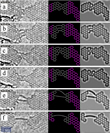Stable carbon chains to form via simple routes from graphene nanobridges
August 19, 2009
ULM - A new study finds that an exotic carbon allotrope is created due to preferred electron beam-induced chemical etching of a graphene nano-bridge.
Theoretically predicted unique properties combined with the existence of two electronically different phases (polyyne (–C≡C-)n and cumulene (=C=C=)n) have already attracted significant interest of the nanotechnology community. Besides spectroscopic evidences for linear carbon chains in space and in solutions, there were no attempts to evaluate the properties of a single carbon chain in relation to its probable application for nanotechnology up to now. This is mostly due to high difficulties of handling of a single linear carbon chain molecule in an experimental setup.
Scientists of Ulm University, group of Electron Microscopy for Materials Science (EMMS) have shown a simple and reliable route for the creation of single carbon chains, starting from a nanobridge (constriction) in graphene created due to preferred electron beam-induced chemical etching of adsorbed dirt on top of graphene. Their data (obtained with an imaging-side CS -aberration-corrected FEI Titan 80-300 operated at 80 kV show that under the particular, but easily achievable conditions, linear carbon chains are energetically preferable over other carbon nanostructures.
The scientists could demonstrate for the first time that these structures are extremely robust against mechanical stresses and radiation. Besides these technologically significant findings at the intermediate steps of the electron beam induced process, the scientists discovered and described a number of curios structural configurations of carbon, which had been theoretically predicted, but never been observed before.
Watch a video of the transformation from a graphene ribbon to a single carbon chain.
Watch a video of the time evolution of a graphene constriction similar to video S1.
Watch a video of the chain formation from a constriction in amorphous adsorbates (i).
Watch a video of the chain formation from a constriction in amorphous adsorbates (ii).
With the present resolution of the TEM study, it could however not be differentiated between the two possibilities of linear carbon chains, the polyyne or cumulene structure. This may have a high relevance for current nano-electronic developments and understanding of carbon chemistry.
In the SALVE I-II project the scientists develop a microscope that has a higher resolution at low voltages. This could allow the distinction between the two linear chain types in the future.
About the article
Title: From graphene constrictions to single carbon chains
Authors: Chuvilin, A., J. C. Meyer, G. Algara-Siller, and U. A. Kaiser
Publication: New Journal of Physics


